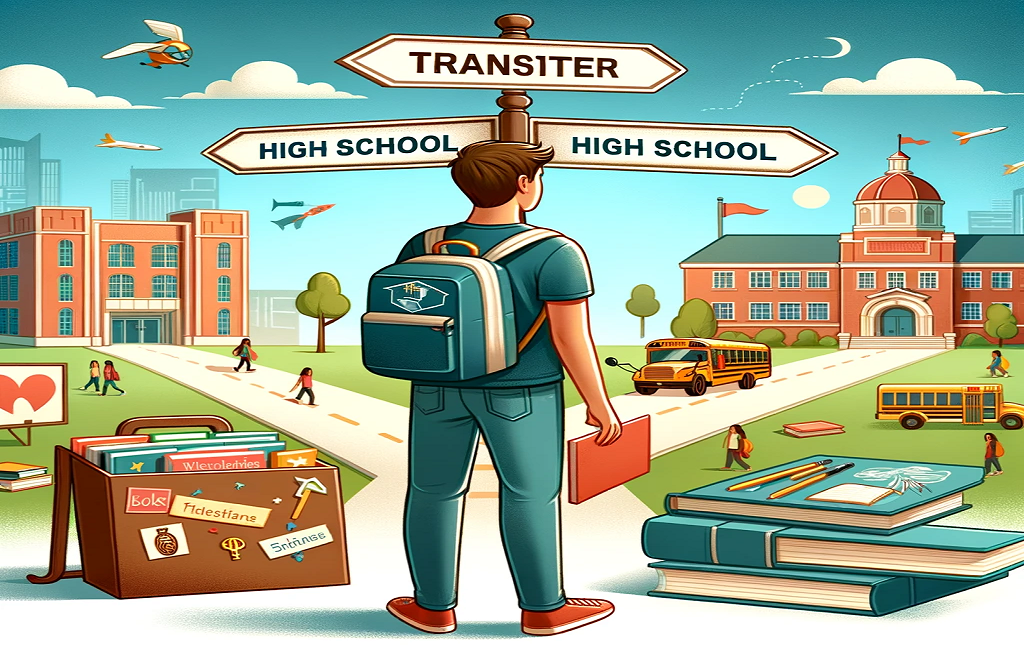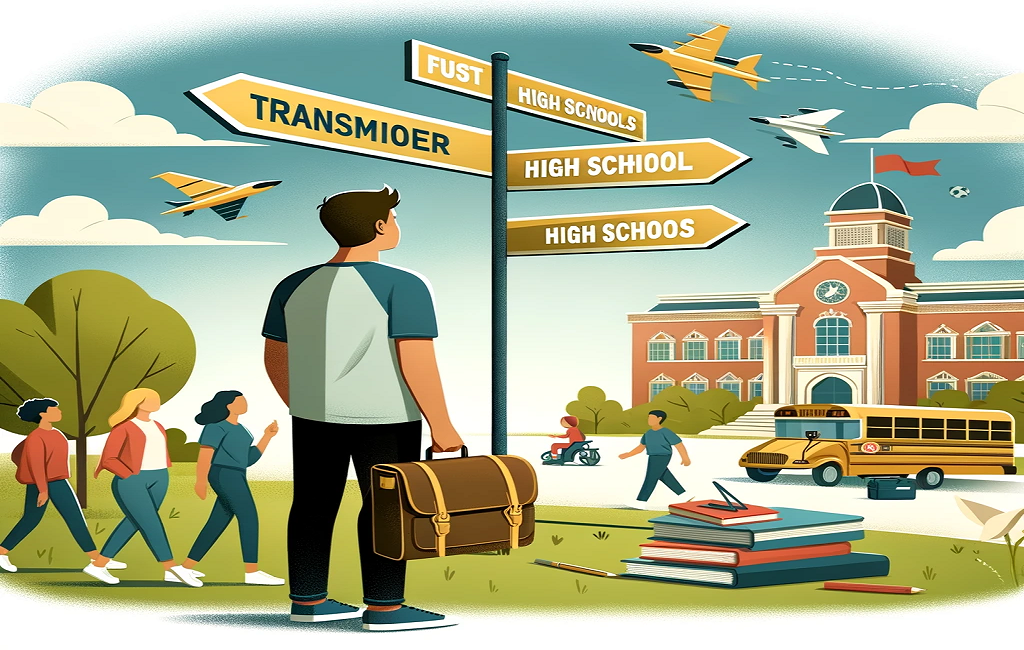
Transferring high schools is a significant decision that can shape a student’s academic journey and personal development. Whether the transfer is driven by the pursuit of better academic opportunities, the need for a fresh start, or other personal reasons, it is a process that involves careful consideration and planning. Understanding the pros and cons of transferring to high schools can help students and their families make informed decisions that align with their long-term goals.
Transferring high schools often arises from a desire to access specialized programs, enhance academic opportunities, or address personal challenges. It might also be motivated by a need for a new social environment, better extracurricular activities, or a move due to family circumstances. Regardless of the reasons, the transfer process can be complex and requires thorough research, preparation, and adjustment.
This article provides a comprehensive overview of the benefits and drawbacks of transferring to high schools. We will explore how such a transition can offer new academic and personal growth opportunities while presenting potential challenges. Additionally, we will provide practical advice on successfully navigating the transfer process, ensuring a smooth transition for students.
This guide examines the positive and negative aspects of transferring to high schools, seeking to equip students and their families with the knowledge needed to make the best possible decision. Whether you are considering a transfer for academic reasons, personal growth, or other factors, understanding the full scope of this decision is crucial for achieving a successful and fulfilling high school experience.

Table of Contents
Pros of Transferring High Schools
Transferring high schools can bring about many positive changes that contribute to a student’s academic and personal growth. Understanding these benefits can help students and their families recognize the potential value of such a transition. Here are some critical advantages of transferring high schools:
Academic Opportunities
One of the primary reasons students transfer to high schools is to gain access to enhanced academic opportunities. Some schools offer specialized programs or advanced placement (AP) courses that might not be available at a student’s current school. These programs can provide a more rigorous academic environment, better-preparing students for college and future careers. Additionally, schools with strong academic reputations can offer unique learning experiences, such as research opportunities, internships, and connections with higher education institutions.
Specialized Programs
Many high schools offer specialized programs tailored to specific interests and career goals, such as STEM (Science, Technology, Engineering, and Mathematics), arts, or vocational training. Transferring to a school with a specialized program can provide students with a focused education and resources in their area of interest, allowing them to develop skills and knowledge directly applicable to their future ambitions. These programs often include dedicated teachers, state-of-the-art facilities, and unique extracurricular activities that enhance the educational experience.
Personal Growth and Development
Transferring high schools can also foster significant personal growth and development. The experience of adapting to a new environment, meeting new people, and overcoming challenges can build resilience, confidence, and independence. Transfer students often develop stronger problem-solving and social skills as they navigate the complexities of starting anew. This growth can be particularly beneficial as students prepare for the transitions and challenges of college and adulthood.
Fresh Start and New Environment
For some students, transferring to high school offers a much-needed fresh start. A new environment can provide the opportunity to redefine oneself and start afresh, whether due to previous academic struggles, social issues, or other personal reasons. A new school can offer a clean slate, free of earlier labels or reputations, allowing students to approach their education and social interactions with renewed enthusiasm and positivity.
Social Benefits
While transferring to high schools can be challenging socially, it also presents opportunities to meet new people and build diverse friendships. A new school environment can introduce students to different cultures, perspectives, and experiences, enriching their social development. Additionally, joining a new community can encourage students to step out of their comfort zones, participate in new activities, and develop a broader social network. These experiences can be valuable for personal growth and future opportunities.
Cons of Transferring High Schools
While transferring high schools can offer numerous benefits, it also comes with its own set of challenges. It is essential to consider these potential drawbacks to make a well-rounded decision. Here are some key disadvantages of transferring high schools:
Adjustment Challenges
The adjustment period is one of the most significant challenges of transferring high schools. Moving to a new school means adapting to a different academic environment, which can be stressful and overwhelming. Students must familiarize themselves with new teachers, classmates, and administrative procedures. The pressure to quickly adapt and fit into a new setting can be daunting, particularly for those who are shy or introverted.
Academic Disruption
Transferring high schools can disrupt a student’s academic progress. Differences in curriculum, teaching styles, and course requirements can create gaps in learning or require students to catch up on new material. This disruption can be particularly challenging for students amid critical academic years, such as junior or senior year. Additionally, credits from the previous school may not always transfer seamlessly, potentially affecting graduation timelines and academic standing.
Social Difficulties
Making friends and establishing social connections in a new high school can be difficult. Existing social groups and cliques may be challenging, leaving new students isolated or excluded. The fear of not fitting in or being accepted can lead to anxiety and stress, impacting overall well-being and academic performance. Social difficulties can be particularly pronounced for students who transfer mid-year or frequently move due to family circumstances.
Loss of Extracurricular Opportunities
Students actively involved in extracurricular activities at their current school may face challenges in continuing their participation after transferring. Different schools may offer varying support and resources for certain activities, and students may find joining new teams or clubs challenging. This loss of continuity can be disheartening for students passionate about their extracurricular pursuits and may impact their overall high school experience.
Financial and Logistical Issues
Transferring high schools can also entail financial and logistical challenges. Costs associated with the transfer, such as new uniforms, school supplies, and potential transportation expenses, can add up quickly. Additionally, families may need to navigate the logistical complexities of moving to a new area or arranging for longer commutes. These challenges can place additional strain on students and their families during an already stressful transition period.

How to Successfully Transfer High Schools
Successfully transferring high schools requires careful planning, thorough research, and a proactive approach to ensure a smooth transition. Here are some critical steps to help you navigate the process effectively:
Research and Planning
Understand Your Reasons for Transferring: Clearly define why you want to transfer high schools. This will guide your decision-making process, whether for better academic opportunities, a specialized program, or personal reasons.
Research Potential Schools: Look for schools that align with your academic goals, interests, and needs. Consider curriculum, extracurricular activities, school culture, location, and support services. Visiting schools, talking to current students, and reviewing school performance data can provide valuable insights.
Check Admission Requirements: Each school has its own admission criteria and deadlines. Ensure you understand the requirements, including necessary documents, application forms, and entrance exams or interviews.
Application Process
Gather Necessary Documents: Collect all required documents, such as transcripts, letters of recommendation, standardized test scores, and other relevant paperwork. Make sure your current school provides updated and accurate records.
Complete Applications Thoroughly: Complete application forms carefully, ensuring all information is accurate and complete. If required, write a compelling personal statement highlighting your reasons for transferring and what you hope to achieve at the new school.
Submit Applications on Time: Pay close attention to application deadlines and submit all materials well in advance. Late applications can jeopardize your chances of acceptance, so plan for any last-minute issues.
Preparing for the Move
Communicate with Your Current School: Inform your current school about transferring. This will help facilitate the transfer of records and ensure a smooth handover. Your current school’s guidance counsellor can be a valuable resource during this process.
Plan the Logistics: Arrange for any necessary transportation, accommodation, or other logistical aspects related to the move. If the transfer involves relocating to a new area, plan the move well to minimize disruptions.
Prepare Academically: Review the curriculum of your new school and identify any differences. If needed, consider taking extra study sessions or summer courses to bridge any gaps and ensure you are prepared for the new academic environment.
Settling into the New School
Attend Orientation Programs: Many schools offer orientation programs for new students. Participating in these programs can help you familiarize yourself with the school’s layout, meet teachers and staff, and make initial connections with fellow students.
Get Involved: Join clubs, sports teams, or other extracurricular activities to meet new people and become part of the school community. Being active in school activities can ease the transition and help you build new friendships.
Seek Support: Don’t hesitate to ask for help if needed. Guidance counsellors, teachers, and peer mentors can provide support and advice as you adjust to your new school. Building a support network can make a significant difference in your transition experience.
Personal Insights on Transferring High Schools
Transferring high schools is not just a logistical or academic decision; it also has profound personal implications that can significantly impact a student’s growth and development. Drawing from professional expertise and personal experience, here are some insights on the broader impact of transferring to high schools.
The Opportunity for Personal Growth
Transferring high schools offers a unique opportunity for personal growth beyond the classroom. Adapting to a new environment, meeting new people, and navigating unfamiliar systems can build resilience and independence. This experience teaches valuable life skills such as problem-solving, adaptability, and interpersonal communication. Students who embrace the challenges of transferring often emerge more robust and self-reliant, better prepared for future transitions, whether in higher education or their careers.
Broadening Horizons through Specialized Programs
One of the most compelling reasons to transfer is the access to specialized programs that align with a student’s interests and career aspirations. For example, a student passionate about engineering might transfer to a high school with a renowned STEM program. These programs offer tailored education, exposure to advanced topics, and opportunities for hands-on experience, which can be pivotal in shaping a student’s future. Access to such specialized education can ignite a passion for learning and open doors to college scholarships and career opportunities.
Social and Emotional Considerations
Social dynamics play a crucial role in a student’s high school experience. Transferring can be socially challenging but also presents a chance to form new, potentially more supportive relationships. In a new environment, students can redefine themselves and seek friendships and social circles that better match their personalities and interests. However, it’s essential to recognize that this process can take time and may require effort and patience.
The emotional impact of leaving behind familiar surroundings and friendships should not be underestimated. Students and parents should be prepared for an adjustment period and seek support when needed. Building a new support network, including teachers, counsellors, and peers, is essential for a smooth transition.
Academic Transition and Adaptation
Academic transition can be one of the most daunting aspects of transferring high schools. Differences in curricula, teaching styles, and educational expectations can create temporary setbacks. However, these challenges can be overcome with proper preparation and mindset. Proactively seeking help from teachers and taking advantage of academic support services can ease this transition. Moreover, the new academic environment might offer better resources, more engaging classes, and a more stimulating learning atmosphere, ultimately benefiting the student’s educational journey.
Fresh Start and Renewed Motivation
For some students, transferring to high school offers a much-needed fresh start. A new school can provide a clean slate, whether due to previous academic struggles, social issues, or personal challenges. This fresh start can renew a student’s motivation and enthusiasm for learning. In a new environment, students can leave behind past difficulties and focus on building a positive, successful high school experience. This can be particularly empowering for students who felt limited or constrained in their previous schools.
Long-Term Benefits
While the immediate challenges of transferring high schools are significant, the long-term benefits often outweigh the initial difficulties. Students who successfully navigate a school transfer develop a strong sense of agency and confidence in their ability to manage change. These skills are invaluable in adulthood, where adaptability and resilience are critical to personal and professional success. Additionally, the enhanced academic and extracurricular opportunities gained from transferring can positively impact educational and career trajectory.
Transferring high schools is a multifaceted decision that can be challenging and rewarding. By considering the transfer process’s personal, social, and academic aspects, students and their families can make informed choices that support long-term success and well-being.

Frequently Asked Questions (FAQ)
How do you write a reason for transfer?
When writing a reason for transferring high schools, it is essential to be clear, concise, and honest. Here are some steps to guide you:
- Start with a Clear Statement: Begin by clearly stating that you are requesting a transfer and briefly mentioning the school you wish to transfer to. For example, “I am writing to request a transfer to [New High School] due to academic and personal reasons.”
- Explain Your Reasons: Provide a detailed explanation of why you want to transfer. Focus on academic opportunities, personal growth, or specific programs the school offers: “The new school offers an advanced STEM program that aligns with my career aspirations in engineering. Additionally, I believe the school’s environment will better support my personal and academic growth.”
- Highlight Positive Aspects: Emphasize how the transfer will benefit you and potentially your new school community. Example: “I am confident that the resources and opportunities at [New High School] will allow me to excel academically and contribute positively to the school community.”
- Conclude Respectfully: End your letter with a respectful request for consideration and provide any additional information that might be needed. For example, “Thank you for considering my request. I am happy to provide any further information or documentation if required.”
How do you ask for a transfer to another location, for example?
Requesting a transfer to another location requires a polite and professional approach. Here is an example of how to structure your request:
- Begin with a Polite Greeting: Address the recipient appropriately. Example: “Dear [Principal’s Name],”
- State Your Request Clearly: Explain your request for a transfer and mention the new location. Example: “I am writing to formally request a transfer to [New High School] located in [City/State].”
- Provide Reasons for Transfer: Outline your reasons for the transfer, focusing on personal, academic, or family-related factors. Example: “Due to a recent family relocation, transferring to [New High School] will be the best option for continuing my education without disruption.”
- Highlight Benefits: Explain how the transfer will benefit you and align with your educational goals. For example, “The academic programs at [New High School] align closely with my interests, particularly in their advanced science courses, which will support my goal of pursuing a degree in biology.”
- Conclude with Gratitude: Express your gratitude for their consideration and offer to provide any additional information. For example, “Thank you for considering my request. Please let me know if there are any additional steps I need to take or information I need to provide.”
How do you write a transfer letter as a teacher?
If you are a teacher requesting a transfer, your letter should be professional and clearly state your reasons. Here’s a structured example:
- Start with a Formal Greeting: Address the letter to the appropriate authority. Example: “Dear [Principal’s Name]/[Superintendent’s Name],”
- State Your Intent: Clearly state that you are requesting a transfer and mention the new school or district. r example, “I am writing to formally request a transfer to [New School/District], effective from the upcoming academic year.”
- Provide Your Reasons: Explain your reasons for seeking a transfer, focusing on professional growth, personal circumstances, or alignment with your teaching goals. E ample: “I am seeking this transfer to better align my professional goals with the opportunities available at [New School/District]. Additionally, this move will accommodate my family’s recent relocation to [City/State].”
- Highlight Your Contributions and Goals: Mention your contributions to your current school and how you plan to contribute to the new school. E ample: “Over the past [number] years, I have enjoyed working at [Current School], where I contributed to [specific programs or achievements]. I look forward to bringing my experience in [subject area] to [New School] and continuing to support student success.”
- Conclude Professionally: End with a respectful note, thanking them for their consideration and offering to discuss further. E ample: “Thank you for considering my request. I am available to discuss this further at your convenience. Please let me know if any additional information is needed.”
Conclusion
Transferring high schools is a significant decision with benefits and challenges. While the prospect of accessing better academic opportunities, specialized programs, and a fresh start can be highly appealing, it’s essential to carefully consider the potential adjustment difficulties, academic disruptions, and social challenges that may arise.
This comprehensive guide has outlined the pros and cons of transferring high schools, providing students and their families with valuable insights to make informed decisions. Understanding these factors is crucial for a successful transition, from enhancing academic prospects and personal growth to navigating the complexities of social integration and logistical adjustments.
Transferring high schools requires thorough research, meticulous planning, and proactive steps to ensure a smooth and positive experience. By focusing on clear communication, preparation, and active involvement in the new school community, students can maximize their new opportunities while minimizing potential downsides.
Moreover, personal insights highlight the transformative potential of transferring high schools. This experience can build resilience, foster independence, and provide renewed motivation and enthusiasm. These personal growth opportunities are invaluable as students prepare for the future, equipping them with skills that extend beyond the classroom.
In conclusion, transferring to high school is a multifaceted decision that must be carefully considered and prepared. By weighing the pros and cons and taking strategic steps to manage the transition, students can achieve a successful transfer that enriches their educational journey and personal development.

